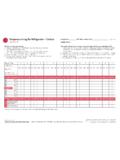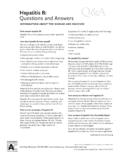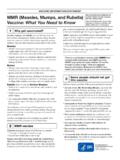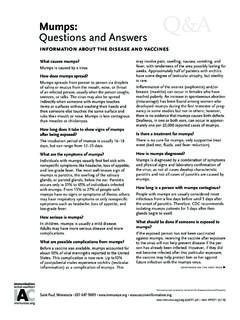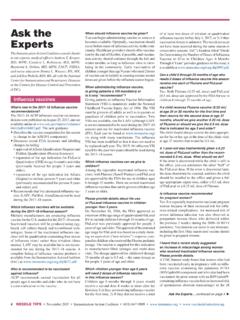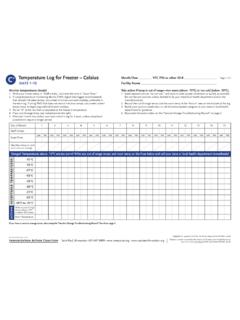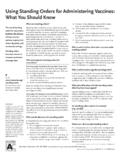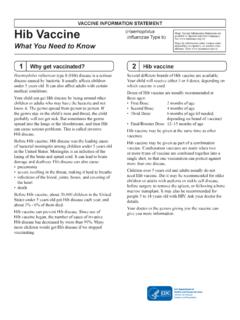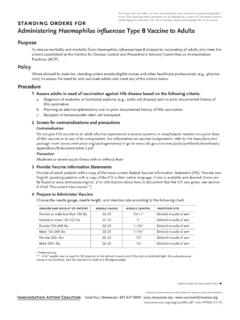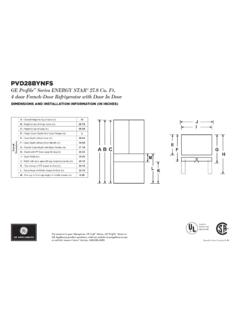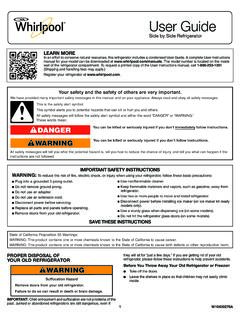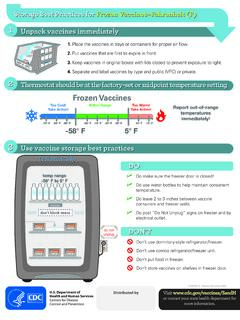Transcription of Temperature Log for Refrigerator -- Fahrenheit
1 Day of Month 1 2 3 4 5 6 7 8 9 10 11 12 13 14 15 Staff InitialsExact TimeMin/Max Temp in Unit(since previous reading)Danger! Temperatures above 46 F are too warm! Write any out-of-range temps and room temp on the lines below and call your state or local health department immediately!46 F45 F44 F43 F42 F41 F40 F39 F38 F37 F36 FDanger! Temperatures below 36 F are too cold! Write any out-of-range temps and room temp on the lines below and call your state or local health department immediately!Write any out-of-range temps (above 46 F or below 36 F) here:Room Temperatuream pmam pmam pmam pmam pmam pmam pmam pmam pmam pmam pmam pmam pmam pmam pmacceptable temperaturesactionAim for 41 If you have a vaccine storage issue, also complete Vaccine Storage Troubleshooting Record found on page Log for Refrigerator FahrenheitPage 1 of 3 DAYS 1 15 Monitor temperatures closely!1. Write your initials below in Staff Initials, and note the time in Exact Time.
2 2. If using Temperature monitoring device (TMD; digital data logger recommended) that records min/max temps, document min/max once each workday, preferably in the morning. If using TMD that does not record min/max temps, document current temps twice, at beginning and end of each Put an X in the row that corresponds to the Refrigerator s If any out-of-range temp, see instructions to the After each month has ended, save each month s log for 3 years, unless state/local jurisdictions require a longer action if temp is out of range too warm (above 46 F) or too cold (below 36 F).1. Label exposed vaccine do not use, and store it under proper conditions as quickly as possible. Do not discard vaccines unless directed to by your state/local health department and/or the manufacturer(s).2. Record the out-of-range temps and the room temp in the Action area on the bottom of the Notify your vaccine coordinator, or call the immunization program at your state or local health department for guidance.
3 4. Document the action taken on the Vaccine Storage Troubleshooting Record on page VFC PIN or other ID #Facility NameF Adapted with appreciation from California Department of Public HealthImmunization Action Coalition Saint Paul, Minnesota 651-6 47-9009 content reviewed by the Centers for Disease Control and Item #P3037F (8/ 18) Temperature Log for Refrigerator FahrenheitPage 2 of 3 DAYS 16 31 Monitor temperatures closely!1. Write your initials below in Staff Initials, and note the time in Exact Time. 2. If using Temperature monitoring device (TMD; digital data logger recommended) that records min/max temps, document min/max once each workday, preferably in the morning. If using TMD that does not record min/max temps, document current temps twice, at beginning and end of each Put an X in the row that corresponds to the Refrigerator s If any out-of-range temp, see instructions to the After each month has ended, save each month s log for 3 years, unless state/local jurisdictions require a longer action if temp is out of range too warm (above 46 F) or too cold (below 36 F).
4 1. Label exposed vaccine do not use, and store it under proper conditions as quickly as possible. Do not discard vaccines unless directed to by your state/local health department and/or the manufacturer(s).2. Record the out-of-range temps and the room temp in the Action area on the bottom of the Notify your vaccine coordinator, or call the immunization program at your state or local health department for guidance. 4. Document the action taken on the Vaccine Storage Troubleshooting Record on page VFC PIN or other ID #Facility NameF Adapted with appreciation from California Department of Public HealthImmunization Action Coalition Saint Paul, Minnesota 651-6 47-9009 content reviewed by the Centers for Disease Control and Item #P3037F (8/ 18)If you have a vaccine storage issue, also complete Vaccine Storage Troubleshooting Record found on page of Month Staff InitialsExact TimeMin/Max Temp in Unit(since previous reading)46 F45 F44 F43 F42 F41 F40 F39 F38 F37 F36 FWrite any out-of-range temps (above 46 F or below 36 F) here:Room Temperatuream pmam pmam pmam pmam pmam pmam pmam pmam pmam pmam pmam pmam pmam pmam pmampm acceptable temperaturesactionAim for 41 16 17 18 19 20 21 22 23 24 25 26 27 28 29 30 31 Danger!
5 Temperatures above 46 F are too warm! Write any out-of-range temps and room temp on the lines below and call your state or local health department immediately!Danger! Temperatures below 36 F are too cold! Write any out-of-range temps and room temp on the lines below and call your state or local health department immediately!Date & Time of EventIf multiple, related events occurred, see Description of Event Unit Temperatureat the time the problem was discoveredRoom Temperatureat the time the problem was discoveredPerson Completing ReportDate:Temp when discovered: Temp when discovered: Name:Time:Minimum temp: Maximum temp: Comment (optional):Title:Date:Description of Event (If multiple, related events occurred, list each date, time, and length of time out of storage.) General description ( , what happened?) Estimated length of time between event and last documented reading of storage Temperature in acceptable range (2o to 8oC [36o to 46oF] for Refrigerator ; -50o to -15oC [-58 to 5 F] for freezer) Inventory of affected vaccines, including (1) lot #s and (2) whether purchased with public (for example, VFC) or private funds (Use separate sheet if needed, but maintain the inventory with this troubleshooting record.)
6 At the time of the event, what else was in the storage unit? For example, were there water bottles in the Refrigerator and/or frozen coolant packs in the freezer? Prior to this event, have there been any storage problems with this unit and/or with the affected vaccine? Include any other information you feel might be relevant to understanding the Taken (Document thoroughly. This information is critical to determining whether the vaccine might still be viable!) When were the affected vaccines placed in proper storage conditions? (Note: Do not discard the vaccine. Store exposed vaccine in proper conditions and label it do not use until after you can discuss with your state/local health department and/or the manufacturer[s].) Who was contacted regarding the incident? (For example, supervisor, state/local health department, manufacturer list all.) IMPORTANT: What did you do to prevent a similar problem from occurring in the future? Results What happened to the vaccine?
7 Was it able to be used? If not, was it returned to the distributor? (Note: For public-purchase vaccine, follow your state/local health department instructions for vaccine disposition.)Vaccine Storage Troubleshooting Record (check one) Refrigerator FreezerUse this form to document any unacceptable vaccine storage event, such as exposure of refrigerated vaccines to temperatures that are outside the manufacturers' recommended storage ranges. A fillable troubleshooting record ( , editable PDF) can also be found at distributed by theImmunization Action Coalition Saint Paul, Minnesota 651-6 47-9009 content reviewed by the Centers for Disease Control and Item #P3041 (8/18)Page 3 of 3 Date & Time of EventIf multiple, related events occurred, see Description of Event Unit Temperatureat the time the problem was discoveredRoom Temperatureat the time the problem was discoveredPerson Completing ReportDate: (see below)Temp when discovered: 45 FTemp when discovered: 77 FName: Nancy NurseTime: (see below)Minimum temp: 38 FMaximum temp: 53 FComment (optional): temp is approxTitle: VFC CoordinatorDate: 6/26/18 Results What happened to the vaccine?
8 Was it able to be used? If not, was it returned to the distributor? (Note: For public-purchase vaccine, follow your state/local health department instructions for vaccine disposition.)Late on Monday, I talked with Victor regarding continued use of vaccine. Victor had checked with manufacturers which confirmed that vaccine is acceptable for use. He told me that vaccine could therefore be removed from quarantine. I discussed the entire situation with Susie Supervisor and Dr. Director (clinic medical director) who agreed that we could put vaccine back in Storage Troubleshooting Record (check one) Refrigerator FreezerUse this form to document any unacceptable vaccine storage event, such as exposure of refrigerated vaccines to temperatures that are outside the manufacturers' recommended storage ranges. A fillable troubleshooting record ( , editable pdf ) can also be found at of Event (If multiple, related events occurred, list each date, time, and length of time out of storage.)
9 General description ( , what happened?) Estimated length of time between event & last documented reading of storage Temperature in acceptable range (2o to 8oC [36o to 46oF] for Refrigerator ; -50o to -15oC [-58 to 5 F] for freezer) Inventory of affected vaccines, including (1) lot #s and (2) whether purchased with public (for example, VFC) or private funds (Use separate sheet if needed, but maintain the inventory with this troubleshooting record) At the time of the event, what else was in the storage unit? For example, were there water bottles in the Refrigerator and/or frozen coolant packs in the freezer? Prior to this event, have there been any storage problems with this unit and/or with the affected vaccine? Include any other information you feel might be relevant to understanding the currently stored appropriately at 41 F. Refrigerator and vaccines labeled "Do Not Use."My State Immunization Program contacted at 8:30 am. Spoke with Victor Vaccine.
10 Provided Victor with details of event and list of vaccines. Vaccine to remain quarantined until we hear back from electric company and confirmed 2 short power outages during Refrigerator seals called Refrigerator maintenance company to replace plug on unit placed tape over plug to prevent inadvertent dislodging. Plan to purchase plug to follow up with Immunization Program on data loggers with alarms that could be sent to coordinator and back-up Taken (Document thoroughly. This information is critical to determining whether the vaccine might still be viable!) When were the affected vaccines placed in proper storage conditions? (Note: Do not discard the vaccine. Store exposed vaccine in proper conditions and label it do not use until after you can discuss with your state/local health department and/or the manufacturer[s].) Who was contacted regarding the incident? (For example, supervisor, state/local health department, manufacturer list all.)
